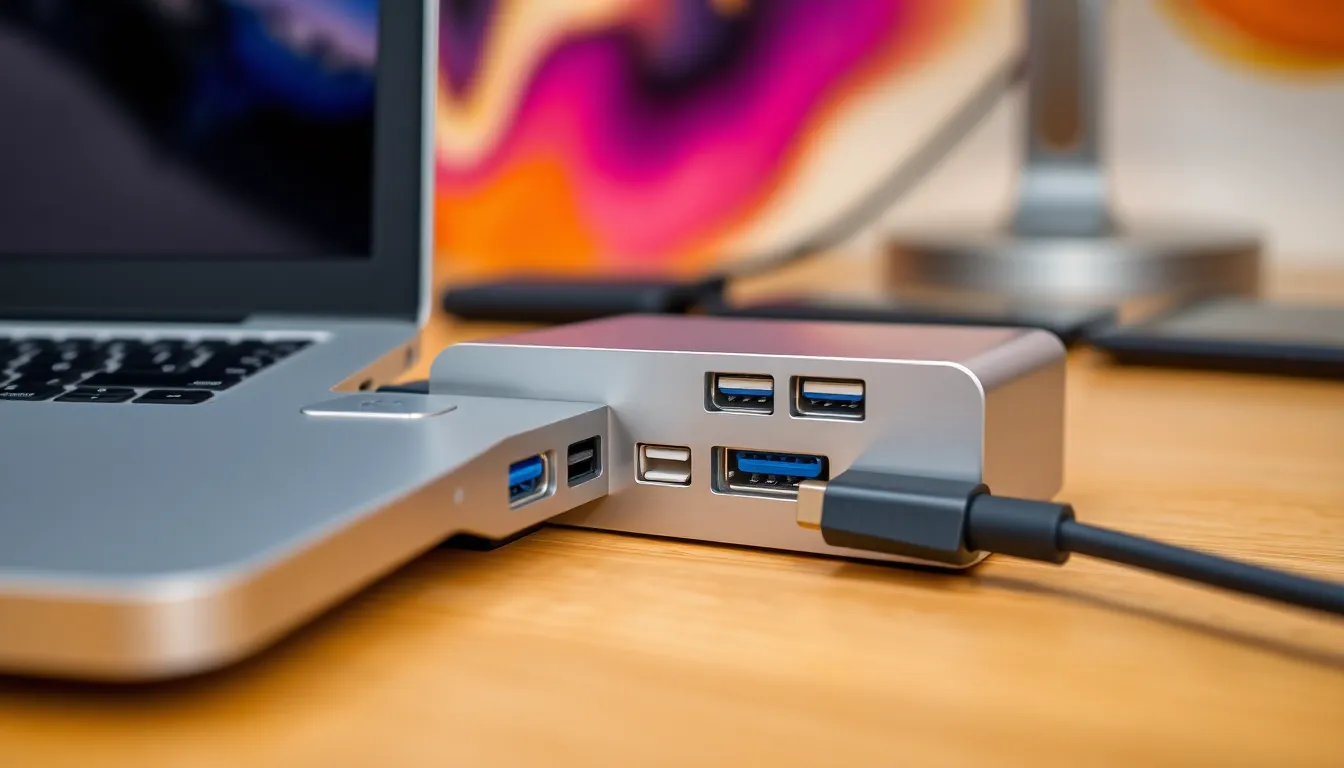In the battle of connectivity, USB and Thunderbolt interfaces are the heavyweight champions. Picture this: USB is like that reliable friend who always shows up to help you move, while Thunderbolt is the flashy tech-savvy buddy who insists on using a drone to do the heavy lifting. Both have their perks, but which one truly deserves a spot in your tech arsenal?
Table of Contents
ToggleOverview of USB vs Thunderbolt Interfaces
USB and Thunderbolt interfaces serve as critical connections in modern technology. USB boasts widespread compatibility, supporting various devices like keyboards, mice, and external storage. Thunderbolt, in contrast, offers high-speed data transfer and versatility, connecting displays, docks, and storage with remarkable efficiency.
Data transfer rates vary significantly. USB 3.0, for instance, delivers up to 5 Gbps, while USB 3.2 can reach 20 Gbps. Thunderbolt 3 and Thunderbolt 4 exceed this, with speeds of 40 Gbps. This stark difference makes Thunderbolt a preferred choice for professionals needing quick file transfers.
The power delivery capabilities differ too. USB can provide up to 100 watts, suitable for charging laptops and peripherals. Thunderbolt enhances this functionality, allowing up to 100 watts as well, along with simultaneous data and video transmission.
Compatibility also plays a role in user choices. USB is universally supported across devices, making it highly accessible. Thunderbolt requires compatible hardware, limiting its availability, though it remains invaluable in high-performance setups.
Both interfaces employ distinct connector types. USB Type-A and Type-C are common, while Thunderbolt uses USB Type-C connectors, ensuring a streamlined design. This connection type fosters increased portability and connectivity.
Looking at the applications, USB fits everyday tasks such as printing and data backup, while Thunderbolt excels in video editing, 3D rendering, and high-speed networking. Users frequently opt for one based on their specific requirements, balancing speed, power, and compatibility. This distinction can significantly influence productivity and efficiency in various settings.
Key Differences Between USB and Thunderbolt

Understanding the key differences enhances the ability to choose the right interface. USB and Thunderbolt differ significantly in speed, power delivery, and compatibility.
Data Transfer Speeds
USB 3.0 supports data transfer rates of up to 5 Gbps. USB 3.2 boosts this capability, achieving speeds of 20 Gbps. In contrast, Thunderbolt 3 and 4 excel, with transfer rates reaching 40 Gbps. These high speeds make Thunderbolt an excellent choice for professionals engaged in large file transfers or demanding tasks. Speed is a critical factor for users relying on quick data access.
Power Delivery Capabilities
USB interfaces can deliver up to 100 watts for charging devices. Thunderbolt also provides this power delivery but supports simultaneous data and video transmission. This combination allows for more efficient workflows, especially when connecting multiple peripherals. Users who need fast charging and versatility benefit from Thunderbolt’s capabilities.
Compatibility and Connectivity
USB enjoys universal compatibility, making it suitable for everyday devices like keyboards and external drives. Thunderbolt, however, requires specific compatible hardware, which can limit its use. Despite this limitation, Thunderbolt remains invaluable for high-performance setups and offers USB Type-C connectors for enhanced portability. The choice between these interfaces often hinges on user needs for power, speed, and device compatibility.
Applications of USB and Thunderbolt
USB and Thunderbolt serve distinct yet overlapping roles in technology today. Understanding their applications helps users select the right interface for their needs.
USB Use Cases
USB finds its strength in everyday tasks and widespread device compatibility. Users commonly rely on USB interfaces for connecting peripherals like keyboards, mice, and printers. External storage devices often utilize USB, making data backup straightforward. The versatility of USB extends to smartphones, where it enables charging and file transfers. Its ability to deliver power and data simultaneously benefits devices such as webcams and game controllers. Overall, USB’s robust compatibility makes it a go-to choice for general computing needs.
Thunderbolt Use Cases
Thunderbolt shines in environments requiring high-speed data transfer and advanced connectivity. Professionals in video editing and 3D rendering frequently turn to Thunderbolt for its ability to handle large files efficiently. High-resolution monitors connect seamlessly via Thunderbolt, providing excellent bandwidth for graphics-intensive tasks. Users engaged in high-speed networking also appreciate Thunderbolt’s capabilities, as it supports daisy-chaining multiple devices without compromising performance. Its unique ability to transmit data and video concurrently optimizes workflows, making Thunderbolt invaluable in performance-driven applications.
Future Trends in USB and Thunderbolt Technologies
Emerging trends indicate a shift toward faster data transfer speeds and greater power delivery capabilities within both USB and Thunderbolt technologies. USB 4, utilizing the Type-C connector, supports speeds up to 40 Gbps, aligning closely with Thunderbolt specifications. Emphasis on versatility ranks high, as USB 4 integrates functionalities from Thunderbolt, allowing users to benefit from improved compatibility and performance.
Developing standards focus on enhanced data management, particularly in data-intensive applications. Enhanced energy efficiency becomes critical as devices demand quicker charging solutions. Future versions of USB protocols are designed to support higher power outputs, potentially exceeding 100 watts, catering to a broader range of devices, including laptops and monitors.
Adoption of Thunderbolt 5 is anticipated, promising even greater capabilities such as support for multiple 8K displays and increased bandwidth. This advancement emphasizes the demand in professional settings, particularly for creators needing robust data handling while multitasking on high-resolution tasks.
Integration of these technologies within a more connected ecosystem accelerates the trend towards universal connectors. USB and Thunderbolt technologies potentially unify further, driving standardization across devices, which simplifies user experiences.
Widespread support for new protocols increases. More devices and peripherals will likely embrace fast charging and high-speed data transmission features. Observing these trends helps users align their technology purchases with future capabilities, ensuring long-term usability and performance in an increasingly digital landscape.
Choosing between USB and Thunderbolt interfaces ultimately depends on individual needs and use cases. USB remains the reliable choice for everyday tasks and broad device compatibility. Its versatility makes it ideal for casual users and general computing.
On the other hand, Thunderbolt stands out for its impressive speed and ability to handle demanding applications. Professionals in fields like video editing and 3D rendering will find its capabilities indispensable.
As technology continues to evolve, both interfaces are poised to enhance user experiences. The integration of USB 4 and upcoming Thunderbolt 5 indicates a future where speed and power are prioritized. Understanding these differences equips users to select the best interface for their specific requirements, ensuring they stay connected in an increasingly digital world.




